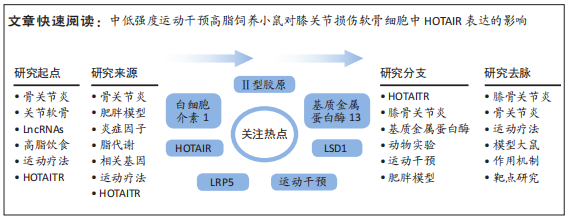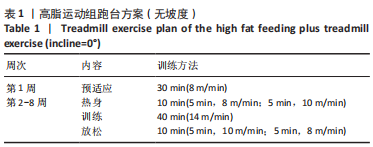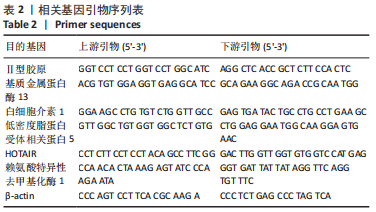[1] VASSÃO PG, PARISI J, PENHA TFC, et al. Association of photobiomodulation therapy (PBMT) and exercises programs in pain and functional capacity of patients with knee osteoarthritis (KOA): a systematic review of randomized trials. Lasers Med Sci. 2021;36(7): 1341-1353.
[2] CHEUNG EC, DILALLO M, FEELEY BT, et al. Osteoarthritis and ACL Reconstruction-Myths and Risks. Curr Rev Musculoskelet Med. 2020; 13(1):115-122.
[3] LEÓN-BALLESTEROS S, ESPINOSA-MORALES R, CLARK-PERALTA P, et al. Kinesiotape and quadriceps strengthening with elastic band in women with knee osteoarthritis and overweight or obesity. A randomized clinical trial. Reumatol Clin (Engl Ed). 2020;16(1):11-16.
[4] 江岩,刘益杰,张玲莉,等.中等强度跑台运动对高脂饮食小鼠膝关节软骨MMP-13、LRP5的影响[J].上海中医药杂志,2017,51(7): 80-84.
[5] CONGER A, GILILLAND J, ANDERSON L, et al. Genicular Nerve Radiofrequency Ablation for the Treatment of Painful Knee Osteoarthritis: Current Evidence and Future Directions. Pain Med. 2021;22(Suppl 1):S20-S23.
[6] TOGNOLO L, MACCARONE MC, DE TRANE S, et al. Therapeutic Exercise and Conservative Injection Treatment for Early Knee Osteoarthritis in Athletes: A Scoping Review. Medicina (Kaunas). 2022;58(1):69.
[7] BRIDGES MC, DAULAGALA AC, KOURTIDIS A. LNCcation: lncRNA localization and function. J Cell Biol. 2021;220(2):e202009045.
[8] PRICE RL, BHAN A, MANDAL SS. HOTAIR beyond repression: In protein degradation, inflammation, DNA damage response, and cell signaling. DNA Repair (Amst). 2021;105:103141.
[9] 王淼,周绪昌,邹军,等.长链非编码RNA:HOTAIR在骨关节炎中的作用[J].中华骨质疏松和骨矿盐疾病杂志,2020,13(1):79-85.
[10] XIN X, LI Q, FANG J, et al. LncRNA HOTAIR: A Potential Prognostic Factor and Therapeutic Target in Human Cancers.Front Oncol. 2021;11: 679244.
[11] WANG B, SUN Y, LIU N, LIU H. LncRNA HOTAIR modulates chondrocyte apoptosis and inflammation in osteoarthritis via regulating miR-1277-5p/SGTB axis. Wound Repair Regen. 2021;29(3):495-504.
[12] HØYDAL MA, KEMI OJ, ELLINGSEN O, et al. Running speed and maximal oxygen uptake in rats and mice: practical implications for exercise training. Eur J Cardiovasc Prev Rehabil. 2007;14(6):753-760.
[13] BOUXSEIN ML, BOYD SK, CHRISTIANSEN BA, et al. Guidelines for assessment of bone microstructure in rodents using micro-computed tomography. J Bone Miner Res. 2010;25(7):1468-1486.
[14] WANG T, GUO Y, SHI XW, et al. Acupotomy Contributes to Suppressing Subchondral Bone Resorption in KOA Rabbits by Regulating the OPG/RANKL Signaling Pathway. Evid Based Complement Alternat Med. 2021; 2021:8168657.
[15] GUILAK F, NIMS RJ, DICKS A, et al. Osteoarthritis as a disease of the cartilage pericellular matrix. Matrix Biol. 2018;71-72:40-50.
[16] DONELL S. Subchondral bone remodelling in osteoarthritis. EFORT Open Rev. 2019;4(6):221-229.
[17] STEWART HL, KAWCAK CE. The Importance of Subchondral Bone in the Pathophysiology of Osteoarthritis. Front Vet Sci. 2018;5:178.
[18] 周绪昌,张苗,邹军,等.长链非编码RNA H19对骨关节炎的影响[J].中华骨质疏松和骨矿盐疾病杂志,2020,13(2):184-190.
[19] 宋校能,胡玲慧,黄德胜,等.运动防治膝骨关节炎的关键因素及注意事项[J].中国组织工程研究,2020,24(2):289-295.
[20] HSU H, SIWIEC RM. Knee Osteoarthritis//StatPearls. Treasure Island (FL): StatPearls Publishing.2020.
[21] 吴伟,焦俊玥,李慧,等.运动对软骨代谢影响的研究进展[J].中国骨质疏松杂志,2018,24(10):1384-1389.
[22] 何健宜,姜梦琪,刘旭丹,等.高脂饮食诱导C57BL/6J肥胖小鼠骨关节炎模型的建立[J].中国组织化学与细胞化学杂志,2017,26(5): 445-450.
[23] MARQUES-PINHEIRO A, LEVASSEUR R, CORMIER C, et al. Novel LRP5 gene mutation in a patient with osteoporosis-pseudoglioma syndrome. Joint Bone Spine. 2010;77(2):151-153.
[24] MEO BURT P, XIAO L, HURLEY MM. FGF23 Regulates Wnt/β-Catenin Signaling-Mediated Osteoarthritis in Mice Overexpressing High-Molecular-Weight FGF2. Endocrinology. 2018;159(6):2386-2396.
[25] LI H, WANG D, YUAN Y, et al. New insights on the MMP-13 regulatory network in the pathogenesis of early osteoarthritis. Arthritis Res Ther. 2017;19(1):248.
[26] CHOW YY, CHIN KY. The Role of Inflammation in the Pathogenesis of Osteoarthritis. Mediators Inflamm. 2020;2020:8293921.
[27] EL-ALI Z, EL-KASSAS G, ZIADE FM, et al. Evaluation of circulating levels of Interleukin-10 and Interleukin-16 and dietary inflammatory index in Lebanese knee osteoarthritis patients. Heliyon. 2021;7(7):e07551.
[28] SUN R, GAO DS, SHOUSH J, et al. The IL-1 family in tumorigenesis and antitumor immunity. Semin Cancer Biol. 2022;86(Pt 2):280-295.
[29] PAPATHANASIOU I, MALIZOS KN, TSEZOU A. Low-density lipoprotein receptor-related protein 5 (LRP5) expression in human osteoarthritic chondrocytes. J Orthop Res. 2010;28(3):348-353.
[30] TAN Z, NIU B, TSANG KY, et al. Synergistic co-regulation and competition by a SOX9-GLI-FOXA phasic transcriptional network coordinate chondrocyte differentiation transitions. PLoS Genet. 2018;14(4): e1007346.
[31] JOHNSON P, LIPOVICH L, GRANDÉR D. Evolutionary conservation of long non-coding RNAs: sequence, structure, function. Biochim Biophys Acta. 2014;1840(3):1063-1071.
[32] XUE X, YANG YA, ZHANG A, et al. LncRNA HOTAIR enhances ER signaling and confers tamoxifen resistance in breast cancer. Oncogene. 2016; 35(21):2746-2755.
[33] ZHANG CP, WANG P, JIANG PF, et al. Upregulation of lncRNA HOTAIR contributes to IL-1beta induced MMP overexpression and chondrocytes apoptosis in temporomandibular joint osteoarthritis. Gene. 2016; 586(2):248-253.
|










